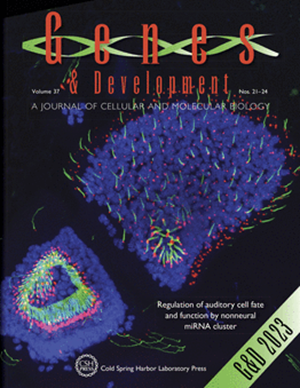SUMO2 promotes histone pre-mRNA processing by stabilizing histone locus body interactions and facilitating U7 snRNP assembly
IF 7.7
1区 生物学
Q1 CELL BIOLOGY
引用次数: 0
Abstract
Histone mRNAs are the only nonpolyadenylated mRNAs in eukaryotic cells and require specialized processing in the histone locus body (HLB), a nuclear body where essential processing factors, including the U7 snRNP, are concentrated. Recent studies have revealed that misregulation of histone pre-mRNA processing can lead to polyadenylation of histone mRNAs and disruption of histone protein homeostasis. Despite links to human disease, the factors contributing to polyadenylation of histone mRNAs and the mechanisms underlying HLB assembly and U7 snRNP biogenesis remain unclear. Here, we report novel functions of the small ubiquitin-related modifier 2 (SUMO2) in promoting histone pre-mRNA processing. Using a SUMO2 knockout osteosarcoma cell line, we identified a defect in 3′ end cleavage and a global increase in histone mRNA polyadenylation. Subsequent analysis of HLBs revealed increased dynamics and reduced levels of the U7 snRNP complex. By overexpressing the U7 snRNP-specific components Lsm11 and U7 snRNA, we rescued U7 snRNP levels and processing defects in SUMO2 knockout cells. Through analysis of Lsm11, we identified a SUMO-interacting motif in its N terminus required for efficient formation of U7 snRNP. Collectively, we demonstrated that SUMO2 promotes histone pre-mRNA 3′ end processing by stabilizing HLB interactions and facilitating U7 snRNP assembly.SUMO2通过稳定组蛋白位点体相互作用和促进U7 snRNP组装来促进组蛋白pre-mRNA加工
组蛋白mrna是真核细胞中唯一的非聚腺苷化mrna,需要在组蛋白位点体(HLB)中进行特殊加工,HLB是一个核体,主要加工因子,包括U7 snRNP,都集中在这里。最近的研究表明,组蛋白前mrna加工的错误调控可导致组蛋白mrna的聚腺苷化和组蛋白稳态的破坏。尽管与人类疾病有关,但导致组蛋白mrna聚腺苷化的因素以及HLB组装和U7 snRNP生物发生的机制仍不清楚。在这里,我们报道了小泛素相关修饰子2 (SUMO2)在促进组蛋白mrna前加工中的新功能。使用SUMO2敲除骨肉瘤细胞系,我们发现了3 '端切割缺陷和组蛋白mRNA聚腺苷化的整体增加。随后对hbs的分析显示,U7 snRNP复合物的动态增加和水平降低。通过过表达U7 snRNP特异性成分Lsm11和U7 snRNA,我们挽救了SUMO2敲除细胞中的U7 snRNP水平和加工缺陷。通过分析Lsm11,我们在其N端发现了一个sumo相互作用的基序,这是有效形成U7 snRNP所必需的。总的来说,我们证明了SUMO2通过稳定HLB相互作用和促进U7 snRNP组装来促进组蛋白前mrna 3 '端加工。
本文章由计算机程序翻译,如有差异,请以英文原文为准。
求助全文
约1分钟内获得全文
求助全文
来源期刊

Genes & development
生物-发育生物学
CiteScore
17.50
自引率
1.90%
发文量
71
审稿时长
3-6 weeks
期刊介绍:
Genes & Development is a research journal published in association with The Genetics Society. It publishes high-quality research papers in the areas of molecular biology, molecular genetics, and related fields. The journal features various research formats including Research papers, short Research Communications, and Resource/Methodology papers.
Genes & Development has gained recognition and is considered as one of the Top Five Research Journals in the field of Molecular Biology and Genetics. It has an impressive Impact Factor of 12.89. The journal is ranked #2 among Developmental Biology research journals, #5 in Genetics and Heredity, and is among the Top 20 in Cell Biology (according to ISI Journal Citation Reports®, 2021).
 求助内容:
求助内容: 应助结果提醒方式:
应助结果提醒方式:


